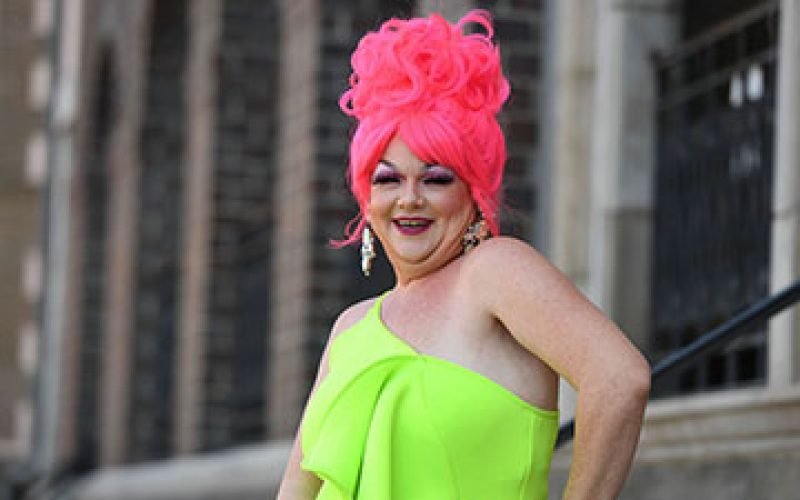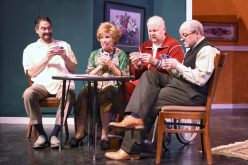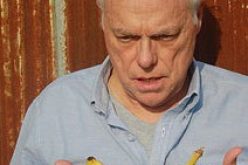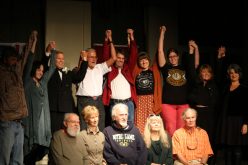Sometimes a queen is what she seems
REGGAN PARRISH
Special to The Free Weekly
Looking into a large mirror, Patty Johnson hums softly to herself and dances in place as she fixes her makeup. Loud thrumming bass music plays in the background as performers run around in various levels of dress, trying to prepare for their first numbers. Everyone is chatting loudly as they check their appearances in lighted mirrors — and Johnson is doing her part to keep everyone in good spirits and excited for the night. It’s just a Wednesday evening, but the show is about to begin.

Patty Johnson of Fayetteville poses in full costume dressed as Lady Kakes Monroe. She is unusual among drag queen performers because she is a woman. “Patty loves unconditionally no matter who you are or how you identify. She’s a leader, and she’s always there to step a stylish heel into a better and brighter future, and she does so with so much passion and pride,” says Malachi Clement, a drag king.
(The Free Weekly/J.T. Wampler)
A well-known figure in the local drag community, Johnson sticks out among the rest, due not only to her outgoing personality, but also because she is what this community calls a “diva queen” — a female drag queen. This is a relatively new trend in the drag community, as most drag queens are male performers, but female drag queens have been a more and more common sight in recent years, Johnson says. A pioneer for female drag queens in Northwest Arkansas, she was not well-received when she began performing in 2010, she adds.
“They had to explain everything to me; I had to look it up. There wasn’t anything like that around here at that time. At all,” Johnson says. “They called me up and said, ‘Patty, you’re from New Orleans, you’ve got wigs and costumes, and you have to do this. It’ll be great!’”
Johnson worked at the Northwest Arkansas Equality center, a nonprofit community education, advocacy, resource and service organization supporting the LGBTQ community, and as a favor to a member, she let herself be convinced to perform during a charity event as a “faux queen.”
After spending some time on the internet, researching just what she was getting herself into, she was hooked.
She gave it her all — days of preparation for 15 minutes of performance. In a costume she’d made herself, and after hours of research and practice, she stepped onto the stage for the first time as a diva queen. And she loved it. It was like nothing she’d ever done before, and it was just as new to the community.
One performance turned into more. Soon enough she was performing at clubs and events all over Northwest Arkansas — but not without difficulties. Johnson experienced a lot of backlash from other performers. She wasn’t like them; she was a “real woman,” as she put it, and they expected her to fall back on that in a way that no male drag queen would be able to. She would not have to worry with extra padding or feminizing her face shape with contouring makeup in order to pass as a woman, and they were afraid that this would make her lazy, or arrogant.

Johnson, in her drag persona “Lady Kakes Monroe,” participates in a digital drag show at C4 Nightclub & Lounge. The club did online shows regularly when the doors couldn’t be open for live performances. “She invests so much time and effort, not only into her drag, but also into the community. And that is what I love most about her,” – says Jeremy Stuthard-Fears, a well-known drag queen whose stage name is Taylor Madison Monroe.
(Courtesy Photo/Reggan Parrish)
In the early days, she was often shunned by drag queens in the community. They would meet her in bathrooms or dressing rooms and tell her that she would never be completely accepted into this world. They told her that they might support her, but she would never be truly welcome, because she wasn’t normal drag. But she used this to her advantage, took the adversity and ran with it. It was what encouraged her to keep going.
Early performances were often worse. Audience members would come up to her and grab her to make sure she was as real as she claimed to be, always coming away shocked at what they discovered but never ashamed of their actions. Johnson kept her cool, steeled herself to the invasion, and kept performing. It was all she could do — show them that she wasn’t bothered. Just as she had always done, Johnson let it go and kept moving forward, improving wherever she thought she needed work.
She is proud to say that she has seen a noticeable increase in female drag queens since her debut in 2010, some inspired by her willingness to pursue her passion despite the hard work and challenges that came with it. Over the years, she’s helped wherever she could and gone so far as to scout new talent when she saw potential. She even started a Drag Boot Camp to give drag performers, new and old, a place to improve and come together to help each other. Drag queens and kings could come with half-finished ideas or projects and get the support they needed to develop them. Around these tables, nestled together in Johnson’s kitchen or back yard, these performers could build bonds as well as costumes.

Patty Johnson concentrates on her makeup as she gets ready for a performance. Bright, exaggerated makeup has been a staple for drag entertainers for decades. “Patty stands out because of how she presents herself. She’s got her own things, and she’s good at drawing in her audience,” says Hannah Schultz, a longtime Northwest Arkansas drag fan.
(Courtesy Photo/Reggan Parrish)
Support can get a performer far in this industry. Willingness to learn from more experienced male queens earned Johnson a lot more respect than she would have gotten had she tried to pave her own way without paying tribute. Now, because of this, she knows how to layer on padding and pantyhose, glue down her eyebrows, and put together incredible outfits for little money, just like any of the experienced male drag queens in the industry. This is what sets her apart from other female queens, she says.
“When you’re willing to learn from them, instead of trying to take the easy way out, you’re a lot more likely to gain the respect of others in the game.”
Even in the face of hardship, she continued to perform. Early on in her years as a drag performer, her husband became ill. He battled for his life against glioblastoma, a rapidly growing brain cancer. The only time Johnson has ever willingly taken a break was to grieve for his passing. She was devastated, and it took a year for her to return to the stage.
Johnson did not discriminate when it came to who she brought into her drag family. This welcoming attitude helped her a great deal when she was ready to get back on the stage. And the support she received from her drag family helped her to give back in return.
“[Johnson] is the one who got me into drag. She basically taught me how to perform, and how to find myself as a drag performer. She’s always been such a big support for everyone in our house, and I try to return that support to her whenever I can,” says Malachi Clement. Clement is a drag king, a performer who takes on a male persona instead of the female persona of a drag queen. He was inspired to start performing after watching Johnson entertain at a club in town.
“She’s probably the most approachable queen I know of in this area,” says Jacob Hiatt, one of Johnson’s three housemates and part of her family of entertainers. “She’s definitely there to help you when you need it, and she’s always looking to take in new people interested in drag. We had to cut her off a while back or she was gonna keep bringing home more.”

Patty Johnson and other local performers wrap up a digital drag show at C4 Nightclub & Lounge. The queens came out to thank the audience and do a final curtain call. “I applaud her for always breaking the boundaries for a bio-queen, for a woman who does drag. She really puts in the work and she’s authentic, and that’s why she succeeds,” says Joey Baker, a local drag performer.
(Courtesy Photo/Reggan Parrish)
This has been the most difficult year of Johnson’s life by her own admission. She has continued to push through and perform with as much passion and enthusiasm as she always has and has kept faith that things will become easier for performing artists in the near future.
“Covid-19 has really negatively affected performers quite noticeably. I was doing performances three weekends out of the month, and that’s three days a weekend. Now I’m lucky to put on makeup once a month,” she says.
Until things improve, she plans to continue doing what she can to support and be a part of this growing and changing drag community. And when things are safer, she would like to reopen the doors for her Drag Boot Camp. But as she stood with the other queens at the end of her first gig in at least a month, Johnson was already thinking of her next costume, her next music mix, her next performance. Resiliency is her cure for adversity in all its forms.
Reggan Parrish is a student at the University of Arkansas and shared this story with What’s Up! from a class with Bret Schulte, associate professor in the School of Journalism and Strategic Media. You’ll be seeing other UA student stories throughout the school year. Email her at rpparris@uark.edu.

Patty Johnson of Fayetteville poses in full costume dressed as Lady Kakes Monroe. She is unusual among drag queen performers because she is a woman. “Patty loves unconditionally no matter who you are or how you identify. She’s a leader, and she’s always there to step a stylish heel into a better and brighter future, and she does so with so much passion and pride,” says Malachi Clement, a drag king.
(The Free Weekly/J.T. Wampler)
FYI
Drag Show
For more on the next drag show in Fayetteville, visit c4nwa.com.










